Cityscape 2008
Returning from a week-long training session in Ireland just 12 months ago, whenever I spoke with any of my British contacts to warn them I was back on this side of the water, almost every conversation would include at least one mention of "CityScape". It seemed that everyone, from small one-man distribution companies to large multinational manufacturers had a whale of a time, and were literally buzzing with excitement at the contacts made, leads garnered and deals done. And all this while I was out in the wind and rain of West Limerick teaching the council boys how to lay a paving over a bridge deck.
Of course, there is the strong likelihood, near certainty some would say, that the unbridled success of CityScape 2007 was in no small part due to my absence and that a splendid time was had by all because of, rather than despite, my commitments elsewhere. However, if that were true, then CityScape 2008 should be an unmitigated disaster, yet on the evidence of the past two days it is at least as successful as last year's event. Rarely have I seen a trade show so busy, so hectic and so well-received by both exhibitor and visitor. In a little over a day and a half of hall-trudging, I didn't hear a single negative remark, and some comments contained such a wealth of superlatives that I began to suspect the organisers had put summat in the water!
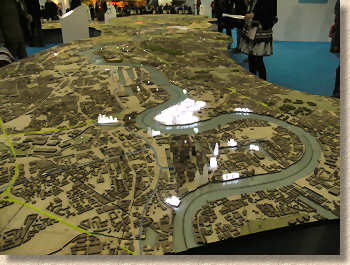
CityScape is one aspect of a multi-faceted mega-show that simultaneously incorporates both EcoBuild and FutureBuild. I'm usually wary of such ambitious shows as experience has taught me that they often attempt to cater to the lowest common denominator. Study of the floorplan during the train journey to Lower Britain on Tuesday morning generated some concern as there was no glaringly obvious boundaries between the three strands and that presented the prospect of having to mooch through stand after stand of irrelevant eco-nonsense and Tracey Island style futurology to find the few gems of hard landscaping. The big block marked “Streetscene” offered some hope, but I've been misled by such grandiose claims in the past and tend to treat them with a healthy degree of scepticism nowadays.
To avoid a flight of inconvenient steps, I made my way into the cavernous Earl's Court Exhibition Centre via Hall II (EC2), which was a mistake, because that was were the organisers had plumped to place most of the larger Carbon Neutral Eco Sustainable Fair Trade Ethically Sourced Environmentally Friendly Green Gubbins, which, while it is undeniably of major significance to the modern construction industry, is not what convinced me to get out of bed and travel 200+ miles to see. So, lots of timber frames, heat exchange pumps and enough green roofs to fill rabbit heaven. Despite scurrying through with the head down, this would not be the last time that green roofs would feature prominently in the events of the next two days.
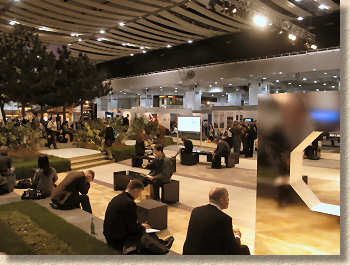
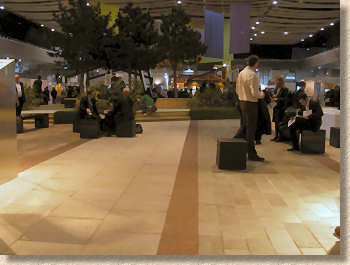
Located at the hub of the CityScape exhibitors, the central streetscaped plaza within the exhibition is an idea borrowed from the lacklustre External Works but done on a grander scale with seemingly more emphasis on form and function rather than product placement. Naturally, the structural materials used in construction were sourced from exhibiting companies but there was more of a sense that their presence had come about more through conscious and deliberate choice and less through contractual obligation, the end result being something that was, at times, choc-a-blockingly popular, with people using it to rest, to read, to eat, drink, and chat, to take and make calls, and do all those things that prove a public space is truly working: it's providing the environment where people feel safe and relaxed, and take the time to unconsciously appreciate their surroundings, without ever descending into sentimentality. And strewn around this central plaza, like pearls about a kissable neck, were the hardscape exhibitors. In no particular order other than the urgency of wanting to impart genuine news, here's a brief summary of who was present and that they had to show.
Charcon
For me, the biggest news from this event was the launch of a new format of paving from Charcon . I was treated to a sneak preview of this around 6 months ago, but sworn to secrecy with the implied threat of having my gonads unceremoniously removed by a blunt and rusty block splitter if I breathed a word to anyone, and ever since I've been bursting with anticipation. Every now and again, you get to see a product or process or tool that just wows the bejaysus out of you, and this new paving is one of those occasions.
As soon as you see it, you understand it, and you understand the possibilities it offers. Despite being lumbered (temporarily, it's to be hoped) with the god-awful name of " StoneMaster ", and despite still being in pre-release beta-format only, even the most myopic Mr Magoo can see that this is an innovative product that offers significant new design opportunities and new markets for modular paving. It offers the colour, texture and distinctive looks of genuine yorkstone, with no hint of cheesiness or simulation. No fake riven-style embossing, no artificial colours, flavours or preservatives, no wishful thinking. This stuff looks, feels, smells and tastes like modular yorkstone.
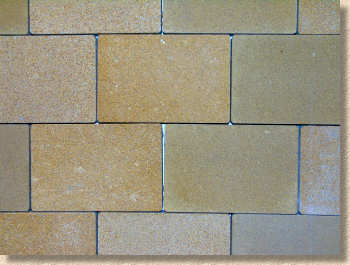
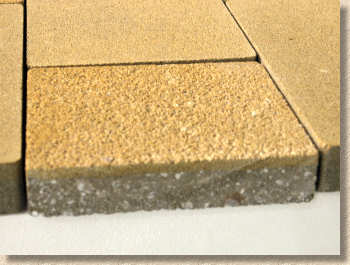
It's a face-mix paver, to be made available in three individual but compatible block sizes, and as a range of modular flagstones. The face-mix is an exceptionally high-quality fine aggregate mix manufactured using genuine yorkstone sands and grits, manufactured to an incredibly tight, close surface finish. The freshly-pressed paving then meets one of three destinies: it can be left to cure with that impeccable surface intact; it can be given a light wash that will remove some of the finer matrix and emphasise the granular texture; or it can be subjected to a slightly more rigorous wash that removes a tad more of the finer material to reveal an even grittier texture.
The plan at the moment is to provide each finish individually, but to encourage on-site mixing and randomisation as this enhances the 'individuality' of each element and recreates to a stunning standard the natural variation in texture and shade that is a major part of the inherent charm of recently-quarried stone. Of course, if a client wishes to use all one type of finish, that will be possible: I have a distinct aesthetic preference for the grittiest finish, as this is incredibly reminiscent of the grittier “Namurian Gritstone” flavour of Yorkstone found on the western flanks of the Pennines where I choose to make my home, but Charcon Yed Cod, Kevin Greaves, has convinced me that the three-finish mix is actually more authentic and attractive when viewed at ground level.
So: we now have a modular paving with all the advantages that offers in terms of laying, versatility, precision and cost, with the aesthetic appeal and benefits of genuine yorkstone. And it's no great leap of imagination to see how this basic recipe can be 'tweaked' to produce authentic-looking paving that's matched for both colour and texture to many native sandstones/gritstones. Soft buffs for Oxfordshire? Piece of cake! Ferric-inspired hues for Northumbria? Aye! Old Red Sandstone for Devon or Dumfriesshire? Nae bother!
Kevin is hoping this will retail at around 30-32 quid per square metre for the 80mm paving. Baby Brother Bradstone will be offering a 60mm version later in the year, and there's the exciting prospect of a stain-protected format that is muck- and gum-resistant. The current version has been produced using the prototype moulds while the actual high-spec working moulds are being honed to perfection by the Charcon elves. It's likely that the flag format will feature a very small chamfer to the edges, while the blocks will probably remain 'unchamfered', assuming they perform well in the forthcoming final installation trials on which I hope to report in a few weeks time.
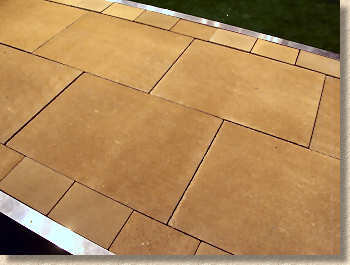
There was, of course, plenty of other stuff on the Aggregate Industries display: permeable pavements in both CBPP and the DrainAsphalt formats from Charcon and Bardon respectively; EcoPave, EcoKerb, Old Town Conservation and a host of other modular paving materials that maximise usage of re claimed or secondary aggs, plus all sorts of developments in macadams, concretes, walling blocks, loose aggregates and SUDS, all of which tend to underline the fact that few companies in our industry have a product range so wide-ranging and therefore so suitable to being pro-actively “greened”. AI's stance on sustainability genuinely seems to be group-wide and based on conviction rather than mere expedience. It sets a standard that others should aim to match or exceed.
CityRoofs
Next: a new name on the scene. Matt Hoddinott has been flying beneath the radar since taking a position with CRH-owned Zoontjens, but now he's back with a bang and in-yer-face with CityRoofs , a new venture that aims to be a one-stop source for all things connected with making the most of the potential unused space of roofs, podiums and terraces. The plan is to provide an eclectic range of products, from Zoontjens, from other CRH brands, and even from non-affiliated companies, then to back up this service with a professional design and advisory team, and then to complete the package by providing experienced and competent specialist installation contractors.
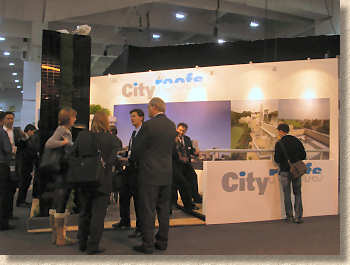
So they have the Marlux range of flagstones with complementary pedestal fittings for roof installations, the Klapps-made exposed aggregate pavers, and the AquaDyne squiggly-plastic-worms drainage board to be used for green roofs and SUDFS installations. Their access to CRH companies enables them to manufacture to order customised pavings featuring colours, textures, sizes and motifs to suit every whim of even the most reality-averse and/or impractical architect or designer.
As mentioned previously, green roofs were a BIG THING throughout this exhibition. A sizable chunk of EC2 was given over to all sorts of vegetation-encrusted roof coverings, and despite the similarity to the weed-riddled thatch roofs of iron-age roundhouses, it's blindingly obvious that this is an idea whose time has come, or come again. What's interesting for those of us with a passion for the hard stuff, more and more green roofs are aiming to incorporate paving and other hard-landscaping features that will open up the prospect of what was previously dead-space becoming a valuable leisure and recreation resource. CityRoofs seems to be ideally placed to offer an all-in service that will help designers and specifiers achieve compliance with Part H and Part L of the Building Regs.
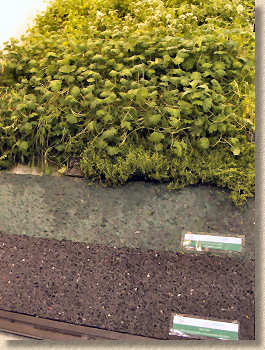 AquaDyne drainage medium as green roof substrate
AquaDyne drainage medium as green roof substrate
Specialist design and advisory services are a growing trend within the hard-landscaping specification market, so the presence of Marshalls behind the scenes at pet urban designers “ Woodhøuse Projects” is entirely to be expected. Woodhøuse aims to be a more architect/designer friendly interface for the whole range of streetscaping problems manufactured by Marshalls and its various subsidiaries and partners.
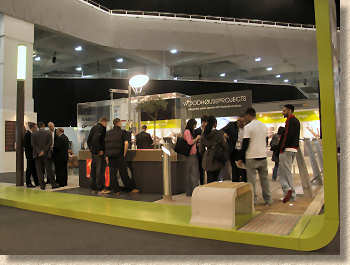
In place of relying solely on the otherwise excellent “Marshalls Product Selector”, Woodhøuse offer the added bonus of creating bespoke items of street furniture, lighting and customised hard-landscaping products, such as the LED tactile surface that changes colour with the traffic lights, or bench stanchions milled from yorkstone that matches the paving. It's aesthetically driven with conceptual design packages augmented by individualisation and aimed squarely at larger commercial projects, but some of the ideas are certain to trickle down to us mortals as their benefits become more widely appreciated.
Formpave were benefitting from the deeper pockets of their new masters, revelling in a much larger display stand than they normally occupy, and it seems to have been a wise move, judging by the non-stop flow of visitors. Indeed, such was the popularity of the show in general and Formpave's offerings in particular that they had to arrange a mercy dash back to deepest Gloucestershire to collect additional literature as their stock had been depleted in record time. Despite now being part of the Hanson conglomerate, it was good to see that they were afforded their own space and not subsumed into the sprawling Hanson display staged in EC2. This allowed them to show off their distinctive pavers and to give deserved prominence to their industry-leading Aquaflow paving systems, a technology which Formpave, probably more than anyone else, pushed to the fore long before it became fashionable.
Development Director, Steve Spikes, was showing a superb video case-study following the installation of permeable block paving to the driveway of a private house, depicting what is likely to become the norm in the light of recent edicts from our beloved political leaders. Apparently, the video is available on YouTube , but quality is compromised due to the bandwidth limitations. However, it's still worth a look because if you're not doing so already, many of us will be using this relatively new method of installation on more and more projects in the future.
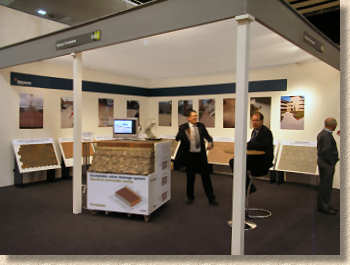
Three of the leading pavement jointing specialists were in attendance, underlining the long-overdue recognition of the importance of sound jointing to long-term pavement performance, and the continued expansion of the market for quality jointing materials. What struck me was the fact that those in attendance represented, between them, what are currently the three most popular solutions to pavement jointing: Gun-injection, slurry grout and epoxy mortars.
Easipoint are the champions of gun-injected mortars, even though their range encompasses slurry grouts. They'd teamed up with the guys from Natural Paving to create a display of jointed granite setts adjacent to a full-size four-metre high site silo, which caused all sorts of fun and games when trying to get it into the exhibition hall. At other exhibitions, a big attraction for the Easipoint stand has been their practical demonstrations, but CityScape isn't that sort of show: not many visitors to this event have ever got their hands dirty, so the Easipoint emphasis is on technical information and “Can Do”, rather than “How-To”.
 AquaDyne drainage medium as green roof substrate
AquaDyne drainage medium as green roof substrate
Romex , meanwhile, decided that a good practical demonstration appeals to potential customers regardless the colour of their collar. With the distribution problems that have dogged the products for the past two or more years now behind them, distributor McMonagle Stone are looking forward to expanded sales volumes and greater market penetration on the right-hand side of the Irish Sea in the coming year.
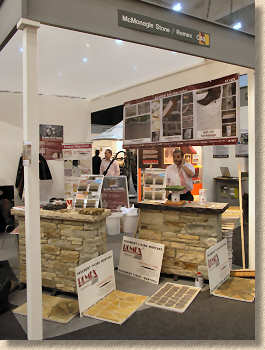
Sales director Michael McMonagle is planning to launch a series of CPD seminars in late spring and urges anyone interested in extending their knowledge of pavement jointing to get in touch and register their interest in attending one of the presentations. Alongside the Romex jointing materials, the distinctive McMonagle Donegal Quartzite was also attracting a lot of attention. In flagstone format it had been used to pave part of the Streetscene plaza, while the on-stand displays showed its versatility as a truly gorgeous walling stone.
Stein-Tec UK has an exemplary track record of proving cement-based slurry grout jointing products backed by decades of research and development in continental Europe. Director David Burton has a simple and practical approach to pavement construction reinforced by a genuine passion for the trade which comes to the fore whenever he gets into conversation. He's recently been involved in work examining the role of microfibres within jointing mortars, and in enhanced-set products that reduce the risk of accidental disturbance of freshly-jointed paving during those critical first few hours.
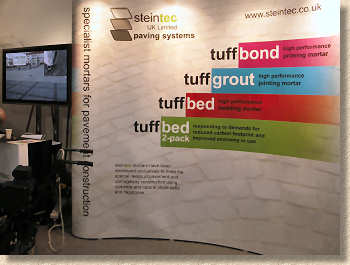
He's also giving a push to a range of “Pavement Aftercare” products for cleaning and sealing. The Weiss products have an impressive reputation in Germany, and there is more than a smidgen of business acumen in David recognising that the long-overdue acceptance of quality jointing is likely to be followed by a realisation that pro-active aftercare makes economic sense when factored into whole-life costs.
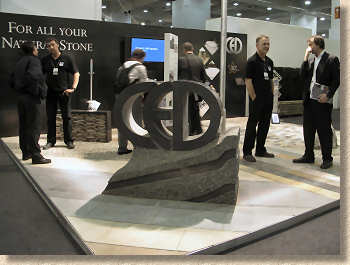
CED has a long association with Stein-Tec, and never fails to put on a visually stunning display of their stone for the discerning designer. This ranges from slates, sandstones and quartzites to reclaimed granite setts and bespoke etching and signage. I was particularly interested in a statement from director Michael Heap regarding the “Carbon Footprint” issues often hurled at the paving industry in general, and the stone trade in particular. He makes an eloquent and well-reasoned case for the use of stone in hard-landscaping, and I hope to be able to reproduce it more fully on this website in the very near future.
Johnsons Wellfield are one of the premier suppliers of genuine yorkstone and were proudly flying the flag for native British stone with their display featuring stone of various colours, textures and finishes. They've now brought in-house all the milling for tactile paving and specialist cutting, which also enables them to use the CNC machine to produce incredibly detailed iconography and lettering. Along with one or two other Cityscape exhibitors, Johnsons Wellfield will be at the Natural Stone Show in a couple of week's time.
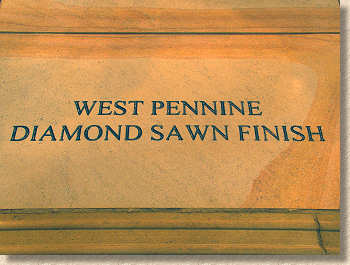
Turning to stone of a smaller scale, SureSet , the resin-bound surfacing specialists, were attracting a lot of attention thanks to their embedded Fibre Optic lighting system. Combined with the translucent ivory-coloured aggregate used as a transition between the timber decking and the hard paving of the streetscene plaza, the tiny spots of light generate an ethereal quality to the surfacing and provide just enough illumination to guide the way during the hours of darkness. And with the lights being based on fibre-optic technology, there's no risk of it failing and requiring expensive replacement, which is often the case with individual LED features.
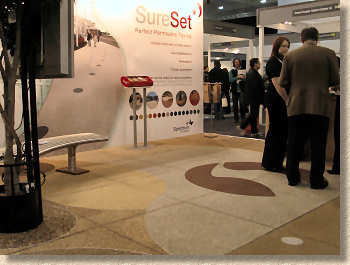
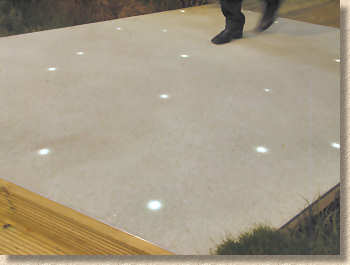
Sales director Victoria Newton reports that the lighting feature comes as a complete stand-alone package that can be easily installed by anyone with Part P accreditation, or by their own specially-trained staff. SureSet had made a further contribution within the plaza area, with half-metre wide strips of a distinctive lavender-coloured tumbled glass being used as delicious break-bands between the expansive panels of stone and textured concrete flagstones. Lavender might not be the first colour that springs to mind when deciding on a complement for quartzite and shot-textured white concrete, but it worked remarkably well.
There are many other companies whose presence deserves a mention, but space and time limit what is possible. Burdens Environmental did a creditable job in sponsoring a huge chunk of the event; AddaStone put on a display of resin bound and bonded surfacing; Geo-Fusion had a confusingly explained but stylishly designed display that had summat to do with permeable paving, but I never really found out what; Enviroglass are a small Shetland-based manufacturer using the recycled glass from that island community as the coarse aggregate component for a range of concrete flagstones; Sutcliffe Play had they type of display that made you want to return to your childhood and clamber over the swings and slides. There were a host of exhibitors with minor or tangential connections to the hard-landscaping trade, and apologies to any that have been missed, but I do think all those with a direct link to the trade have been given at least a mention.
Overall, CityScape (or whatever you want to call it) exceeded expectations and really could become the benchmark event for the commercial hardscape industry, given the biennial lacklustre performance of External Works. Every exhibitor to whom I spoke expressed delight with the turnout and with the “quality” of the visitors. Yes: there was some eco-bollocks on show, featuring zany ideas of limited or non-existent commercial viability, and there was some unconvincing greenwash, but most exhibitors had genuine intentions and there does seem to be an industry-wide acceptance than sustainability is a fact. It is no longer a subject that can be brushed aside with a few mealy-mouthed mumblings, but a fully-fledged component of the construction industry of the 21st century.
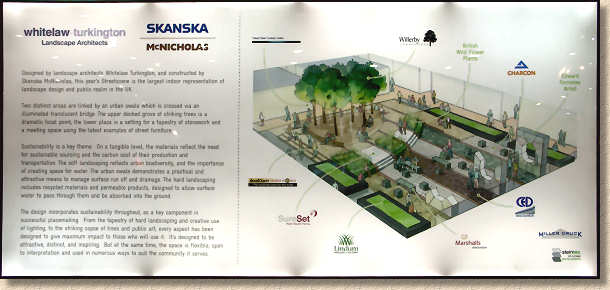
One question that has to be addressed concerns the definition we have for “sustainability” and what it means for the hard-landscaping industry. Regardless of whether we choose concrete or clay, stone, ceramic or bitmac, hard-landscaping involves quarrying at some point in its production. We will never change that, but we can take steps to minimise the impact it has, whether it be in more efficient transport, greater use of secondary aggregates, or something as simple as reduced wastage. However, the single most effective contribution we can make to sustainability is to create pavements and hardscapes that function and endure. When a streetscape requires replacing in 10 years time because it's jaded or failed, that cannot be considered sustainable, but by choosing the best products and making sure they are laid in accordance with best practice to the highest standards of workmanship, we can have paving that will outlast our grandchildren and even our grandchildren's grandchildren. That, for me, is sustainable construction. You can't make an omelette without breaking eggs, but by choosing the best eggs, and making sure the pan is properly prepared, fewer of those omelettes end up as the dog's dinner.


